Thursday, January 11, 2024
Dali and the Cangshan
Dali is a city in western Yunnan that has a pleasant all year climate due to its altitude which is roughly 2000 meters. It is spring like more or less year round, not too hot and not too cold. We flew in to Kunming then took a train to Dali. The train station is in the new city which is larger and pretty much the same as any other Chinese city but not as big. Our accomodations were in the old city however, so we took a taxi to get there. The old city is far more charming than the new, smaller buildings, streets full of restuarants and other businesses and folks having dinner outside sometimes. Its quite lively with tourists, but again the tourists were pretty much all Chinese from what I could tell. I'm sure there were more "laowai" tourists in the past and I suppose there will be again one day. Our friend has another friend who has basically a bed and breakfast sort of place at her home and it was quite nice and different, reminding me in some ways more of California than China. One opens a gate after going through some back alleys and inside is a lovely small yard with roses and an Osmanthus fragrans (Gui hua) tree and a pear tree. Sadly I cannot smell the fragrance of this particular species, which must be genetic, as it is held in much esteem by Chinese for that fragrance. Roses line a fence and in a small bed near the kitchen, and there is also a rooftop garden with lavender and other plants, including some familiar South African species like Felicia aethiopica.
The next day we were off to Cangshan, which is a mountain range to the west of the city which has a few different access points where one can either hike or take cable cars up. We did the cable car and then decided to walk down. It was quite a walk, my iphone told me I walked 6 miles that day and indeed my feet were sore. So sore I asked my wife to just bring me food rather than to go out that night but I did go afterwards with her and Yijia to get a foot massage. It was well worth it.
The flora on the mountain was amazing and we didnt go to the very top, that would have been another cable car or hike. Still I got to see treasures like a tiny roscoea, a beautiful little blue cyanotis sp (again something I am familiar with from visits to South Africa but didnt know existed in Asia), a stunning red flowered bush (a species of Colquhunia) and a lovely Thalictrum among others.
Below is a cool fern in the garden in the place we stayed at
Osmanthus fragrans known as Gui Hua in Mandarin
Euryops sp is a commonly seen daisy along roadsides (where it is frequently planted) and was in the garden. It is a South African species that likes the cool air at this altitude
A beautiful rose in the garden. Nicely fragrant too.
Hydrangea plantings. Not among my favorite flowers but they appeal to many and are long lasting. I do like the roses on the fence.
These yellow lycoris, possibly L aurea, were quite spectacular near the entrance to one of the Cangshan cable cars.
Yijia and Grace as we get ready to go up the cable car
View looking back towards Erhai Lake which is itself an attraction we will have to explore next time.
We could see the plants below the cable car of course. This photo shows a giant attractive fern with leaves that divide into five parts. We would see this fern elsewhere on our trip too.
The first of several impatiens I would find on this trip, a genus I find interesting and also apparently have a good eye for spotting. This species had rather small white flowers and was just begining to set seed pods.
As we began our walk down the path went along a stream bed and here I saw Impatiens arguta for the first time in habitat. I would see it again as well. I grow this species in our gardens in New York but the 2 clones I have do not set seed so I wonder if they are hybrid or are self sterile. Both came from a friend in California, one grows more upright and hates our summer heat, the other looks similar to what I saw on the trip but of course in a garden they grow larger. Both forms are hardy with a winter wood chip mulch.
A tiny species of Roscoea, a group of hardy gingers, grows on this mountain.
I can't read Chinese characters but there was some interesting writing on one of the rocks near the path
Ferns are abundant and varied in Chinese forests.
A white flowered lysmachia species and more roscoea made for a pretty sight
A closeup of a brilliant blue cyanotis species. It was a small plant that surprised me, as I am used to seeing them in the highveld in South Africa on trips there but did not know this genus extends into Asia.
A closer view of the white Lysmachia species. Quite a showy species indeed.
This begonia species was not uncommon in this area. The flowers tended to be on the small side but still it was attractive as just about all begonias are.
This species of Colquhounia is much more attractive and early blooming than C. coccinea which I grow by the house and protect in winter. I wish it had seed on it but alas there were none. It should be introduced into cultivation, it might be hardy and certainly would have merit with those showy flowers in late August, a time when the garden is often in a bit of a lull before the cooler weather of September comes.
Colquhounia species-a better view of the plant. It sort of reminded me of a showy butterfly bush (buddleia) but of course its in a completely different family, the mint family (Lamiaceae).
A view of the pretty much unreachable mainly coniferous forest nearby. Slopes are steep here.
A Codonopsis species often can be a surprisewith its large blue flowers that appear suddenly, but they are on a slender vine that twines its way through other kinds of plants.
At one point we came across a giant replica of a Chinese chess board, or at least I think it was. Interesting and photogenic but of course I prefer to look at the plants.
A species of rose with a few fruits.
A bright yellow creeping lysmachia species.
We didnt see a lot of butterflies and it was still harder to catch a photo of one.
Another attractive fern species.
An arisaema species among some ferns.
I think this is actual Kudzu (Pueraria montana) or something related to it. I have to admit it was quite pretty in bloom and though strong growing it did not show the smother everything else for miles habit it has in our southern states of the US. Perhaps it is a less vigorous variant or species or more likely its native predators keep it in check in its natural habitat.
A beautiful white anemone, probably A hupahensis, which I have seen in more abundance in a part of Sichuan on an earlier trip.
Apios carnea shows its pretty flowers but gives no hint of its potential in cultivation. I can speak to the latter, having recieved seed from a collector some years ago. I still protect the roots of my plant each winter which grows rapidly up a large rhododendron bush come spring and is festooned with long trusses of flowers in early September. A very showy vine, far more attractive than either of our two native species of Apios. It doesnt bloom for long, at least not in New York, and it requires hand pollination to set more seed. I assume a bird of some sort must pollinate it in its native habitat.
Another Impatiens arguta. This species was not rare on our trip and I did see plants with seed pods so I know that wild populations set seed unlike what is in cultivation. Actually now that I think about it, there is one form that does seed around, a white form that I also acquired from California. It is hardy in zone 7a with or without mulch, though I always protect a couple of plants just in case we have a bad winter.
We came across a group of guys with horses carrying stuff up the path. Both were getting a good workout.
Legumes of all kinds abound in China and this region was no exception. Here I hold what I think is a species of Indogifera. Quite nice.
Even nicer was this robust Thalictrum species. Tall with light purple flowers, it leaned out towards the light from the mass of other plants around it.
A closer veiw of the Thalictrum.
A bush near the stream bed with purple berries. No idea of the genus.
Another nice indogifera sp, this one with a shorter pink inflorescence.
A shrub that somehow seems like I should know what it is but I don't. It forms a three winged seed pod.
The pretty blue dwarf cyanotis species. Doesnt appear to form tubers like its relatives in Africa.
A dainty flower of some kind of cucurbit. Not a family that the word "dainty" gets used often in descriptions thereof.
A white flowered aster species.
The white aster shrub, it looks as though it does not die back to the ground in winter like most asters do.
Looking up towards a ridgetop.
A pretty purple corydalis that grew near the path.
A pale form of Impatiens arguta or a related species perhaps.A very pretty legume, maybe a species of Desmodium, it also had silvery foliage.
A very pretty legume, maybe a species of Desmodium, it also had silvery foliage.
A species of Vigna, not unlike its relatives in Africa.
Yet another nice legume, maybe an indogifera, maybe not, but pretty nonetheless Another view of same
Another view of same
A Berberis species in fruit.
A gesneriad, possibly a species of Raphiocarpus, quite ornamental.
A small fern hangs from a rock.
A closer view of the flowers of the possible Raphiocarpus species.
Fern sori on the back of a fern frond. The sori are filled with spores which are the reproductive structures of ferns. They arent hard to germinate in most fern species but it does require a little bit of knowledge about how to do so.
A begonia species in flower among other plants.
A near white Adenophora species. This genus is not uncommon in China and reminds me of Campanula to which it is related.
Parochetus communis, a blue flowered creeping legume species found in the highlands of east Africa and in east Asia.
A Hedychium species that was difficult to photograph because it always grew in inaccessible places, often near a sharp drop so one best not get to close to it.
A Buddleia species, one of many we would see in Yunnan.
A closer view of the Buddeia flower spike.
A spirea with pink flowers, it grew near an old cemetery that was near the path as we got closer to the bottom of the mountain.
Osbeckia chinensis, a pretty herbaceous member of the Melastomaceae.
A paler form of Osbeckia in bud
A darker form of Osbeckia in bud
Murdannia species and a Sanguisorba sp in flower. Murdannia is another genus I have seen before in Malawi and also have grown. This species was hard to photograph but is quite pretty with mostly basal leaves and flowers in shades of purple.
A fairly tall perennial species of Impatiens with large leaves and flowers
Another impatiens, maybe a different color form of arguta or perhaps something else.
A different, probably annual, impatiens species with nicely marked pink flowers. It grew not far from the end of the path, and was in seed.
A closer view of the annual impatiens flower.
Time for a serious foot massage after the long trek down the mountain, but first the feet need to be soaked in a herbal solution of some sort.
A colorful map of the area including Erhai lake, in a restaurant near where we were staying in the old city of Dali.
The rooftop garden where we were staying had quite a few plants in containers.
Felicia aethiopica, a well known plant from South Africa, growing here on a rooftop in Dali.
Lavender spills over the edge of the rooftop garden.
Waterlilies do well in tubs here, it will never be too cold for them here. Nor will it be very hot either, its a place of eternal spring climate, except at higher elevations where actual winter does happen.
Plumbago auriculata, another South African species, grows very well in Yunnan.
Its a near perfect climate in Dali for roses and this one shows it, look at all those color changing flowers on what I think is one plant.
The kitchen at the place we stayed. Windows always open to the garden and lots of cool fresh air.
Can't really read most of what is on the chalkboard in the kitchen but it gives off California vibes somehow.
Our travel companions at a nice dinner.
Driving out of Dali on our way towards Burma we came across a pink form of Hibiscus paramutabilis. I have grown the red eyed white form from Plant Delights which is perfectly hardy in New York, but voles ate the roots a couple of years ago and killed it. Seedlings coming up near the mother plant will bloom next year and are hopefully true, and it also hybridized readily with H. syriacus near one of our property borders where a stand of the latter is present on the neighbor's property. I had never seen the pink form before and Plant Delights no longer sells it or the white form for that matter, so it was a real treat to find it in Yunnan. It was the only plant of this species we saw on this trip.
A view of the rather large bush of Hibiscus paramutabilis.
The large flower and leaves of H paramutabilis are more attractive to me than H. syriacus. Hybrids between them are intermediate in appearance and vigorous too.
One of the great rivers that emerge in Tibet and flow south or east. This might be the Salween or Mekong, not sure as I dont recall a sign. We would see others later on and all were chock full of sediment from the summer rains eroding away soil in the highlands.
A species of Taxus, probably T. chinensis, growing at an old former hotel iirc.
In the lobby of a hotel on our journey towards Burma there were wooden sculptures that were quite exquisite.
This tiger sculpture was quite impressive.
Also impressive was this nice cymbidium clump in full bloom on the lobby desk. Its probably one of the warmer growing Cymbidium hybrids.
Not quite sure what this wooden sculpture represents but I like it.
Finally we arrived in a pine forest that was obviously planted as a source of wood. Athough we did not see any, it was obvious that sheep or some other ruminant animal grazed in this forest as well. Here a small species of Arisaema is in leaf.
More of those cool giant ferns with five parted fronds.
Small orchids of two species had taken root on some of the pine trees. Not sure of this species as it was not in flower nor immediately recognizable to myself.
Another arisaema in leaf.
On another tree a species of Bulbophyllum was growing along with a fern. This area would experience at least some winter frost so any epiphytic orchids here must be more frost tolerant than usual.
Parochetus communis in flower, there were many plants of it on the forest floor but very few flowers at this time of year.
This could be something in the Gentianaceae but its hard to tell without flowers.
A nice species of what I think was Stewartia. Only saw one tree in flower and no seedlings nearby, probably the sheep ate them.
This arisaema was in fruit. Luckily arisaema are not eaten by grazing animals so they are actually favored by the animals eliminating much of the competition.
This arisaema had a beautifully silver patterned leaf.
I don't usually see a lot of wild animals on my trips to China so it was nice to see this toad looking quite content in its habitat.
Polygala is a favorite genus of mine, they are found worldwide but few species are actually in cultivation. Even rarer to see, at least for me, was a shrub/small tree sized member of this family of plants. Not sure of the genus, that will require more research.
Like all things in the Polygalaceae, the seeds are tricky to spot as they often appear in a fading flower and drop off with the flower. This one had seeds that had an aril on them, so presumably some insect carries them into the soil.
A flower of the Polygalaceae shrub. They appear to open for a short time but even the fruits are colorful.
Cool, more silver marked arisaema leaves! Bridget W, are you reading this? :)
Persicaria species, the genus is diverse and abundant especially as one goes higher up. Many form mats and just about all are colorful in flower and often have appealing foliage as well. What I think is a species of Stellaria is also seen with white flowers.
There was an unusual narrow leaved arisaema in this forest. This one appears to be going dormant but many others were still quite green.
A Rodhea species growing among some bushes. Didnt see a lot of them so don't know if it was something the sheep would eat and it got lucky to be out of reach or just wasnt common there.
A young narrow leaved Arisaema sp.
Yet more of the massive fern with five parted fronds. You can guess I really like this one.
After some thought and observation, I realized that these little ferns are probably the juvenile form of the much bigger five parted frond species.
The narrow leaved arisaema species, this time with a seed head. Later on, probably in September, these berries will turn red and the seeds will eventually be dispersed.
More of the narrow leaved arisaema species.
And after another day of botanizing, a nice bowl of typical Yunnan noodle soup awaits.
Subscribe to:
Post Comments (Atom)
































































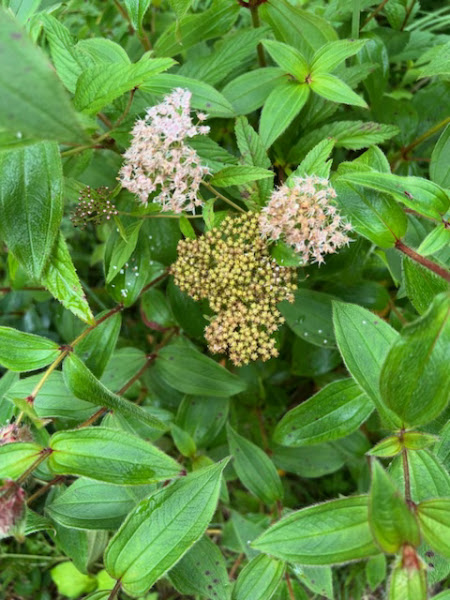













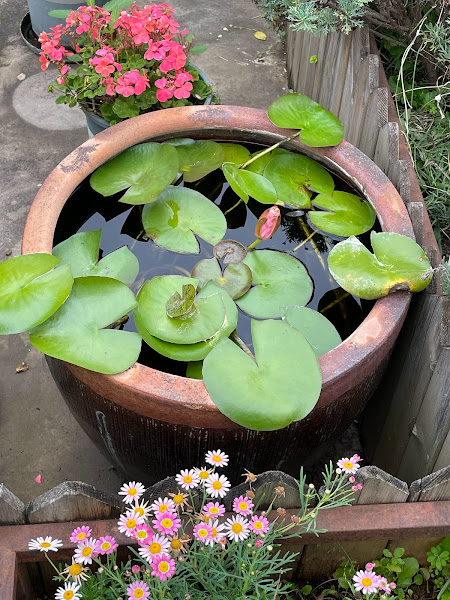

















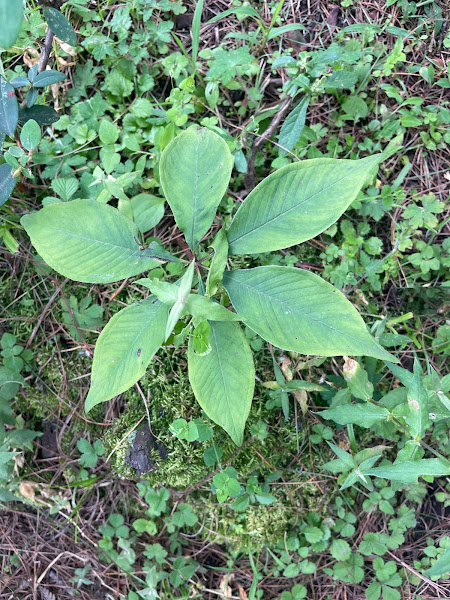

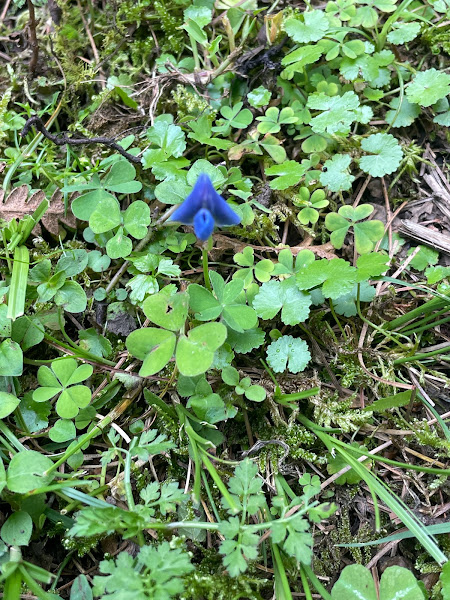









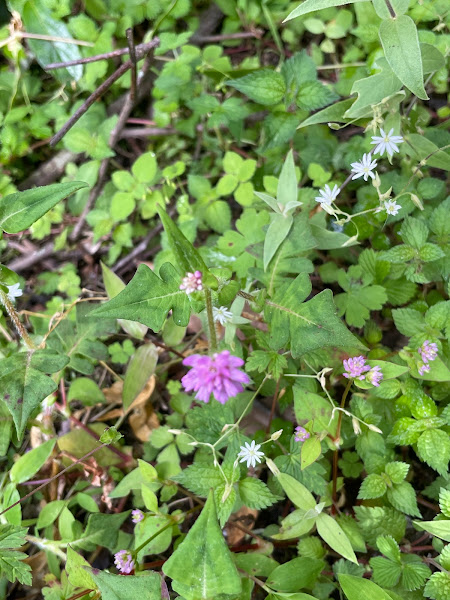
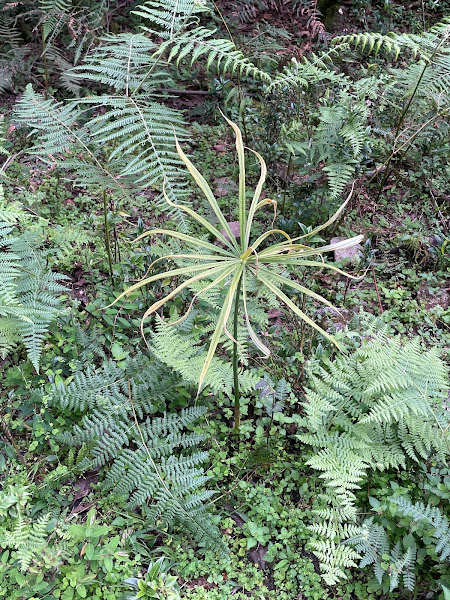
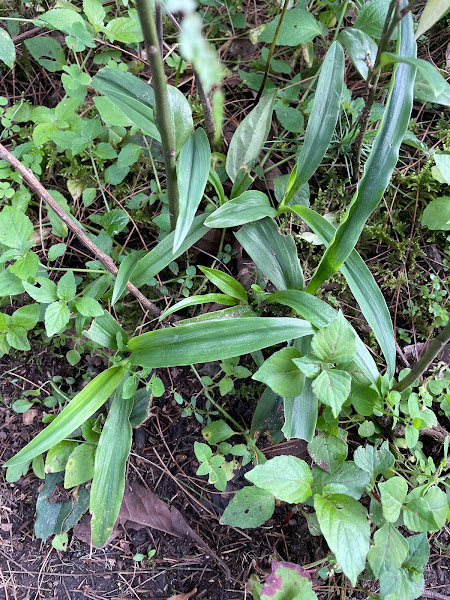






No comments:
Post a Comment